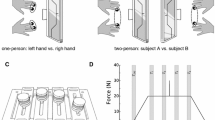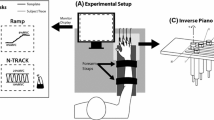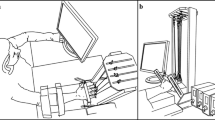Abstract
The aim of this study was to test Bernstein’s idea that motor synergies provide solutions to the motor redundancy problem. Forces produced by individual fingers of one hand were recorded in one-, two-, three-, and four-finger tasks. The subjects (n=10) were asked to produce maximal total force (maximal voluntary contraction, MVC) and to match a ramp total force profile using different combinations of fingers. We found that individual finger forces were smaller in multifinger MVC tasks than in single-finger tasks. The deficit increased with the number of fingers involved. A saturation effect was observed: when several effectors were involved, adding a new effector did not significantly change the total force output. The data confirmed the idea that the central neural drive arriving at the level of synergies has a certain limit, a ceiling, that cannot be exceeded. The central nervous system cannot maximally activate the muscles serving all the fingers at the same time. Secondly, during the course of ramp trials, forces produced by individual fingers were linearly related to each other. Hence, a force sharing pattern was established at the beginning of the trial and did not change during the ramp period. A hypothesis is suggested that force distribution among fingers may be organized so as to minimize unnecessary rotational moment with respect to the functional longitudinal axis of the hand. Finally, in the four-finger trials, variance of the total maximal force output in ten consecutive attempts was smaller than the sum of variances of the maximal individual finger forces. The finding suggests that the control system of the motor tasks studied involves at least two levels, a central neural drive level and a synergy level. At the synergy level, an intercompensation in individual finger force production is observed.
Similar content being viewed by others
Author information
Authors and Affiliations
Additional information
Received: 4 December 1996 / Accepted: 1 September 1997
Rights and permissions
About this article
Cite this article
Li, ZM., Latash, M. & Zatsiorsky, V. Force sharing among fingers as a model of the redundancy problem. Exp Brain Res 119, 276–286 (1998). https://doi.org/10.1007/s002210050343
Issue Date:
DOI: https://doi.org/10.1007/s002210050343




